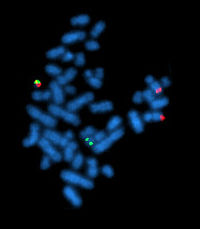
Photo from wikipedia
Background This study aimed to improve the understanding of acute myeloid leukemia (AML) secondary to chronic lymphocytic leukemia (CLL), and to explore the sequence of occurrence and clonal origin of… Click to show full abstract
Background This study aimed to improve the understanding of acute myeloid leukemia (AML) secondary to chronic lymphocytic leukemia (CLL), and to explore the sequence of occurrence and clonal origin of the two diseases. Case Report We reported a case of a 71-year-old man with a history of CLL. The patient was administrated with chlorambucil for 19 years and was admitted to our hospital due to fever. Then he was subjected with routine blood tests, bone marrow smear examination, flow cytometric immunophenotyping and cytogenetic analysis. A final diagnosis of AML-M2 secondary to CLL with -Y,del(4q),del(5q),-7,add(12p),der(17),der(18),-22,+mar was made. After rejecting the therapy with Azacitidine combined with B-cell lymphoma-2 (Bcl-2) inhibitor, the patient died of pulmonary infection. Conclusion This case highlights the rare occurrence of AML secondary to CLL after prolonged chlorambucil therapy and the poor prognosis of such cases, underscoring the importance of enhanced assessment of these patients.
Journal Title: Pharmacogenomics and Personalized Medicine
Year Published: 2023
Link to full text (if available)
Share on Social Media: Sign Up to like & get
recommendations!